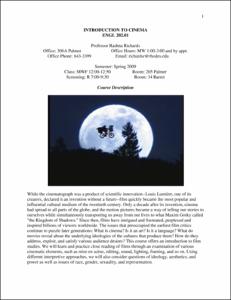Please use this identifier to cite or link to this item:
http://hdl.handle.net/10267/3478Full metadata record
| DC Field | Value | Language |
|---|---|---|
| dc.contributor.author | Richards, Rashna | - |
| dc.date.accessioned | 2009-02-20T17:24:28Z | - |
| dc.date.available | 2009-02-20T17:24:28Z | - |
| dc.date.issued | 2009-01-14 | - |
| dc.identifier.uri | http://hdl.handle.net/10267/3478 | - |
| dc.description | This syllabus was submitted to the Office of Academic Affairs by the course instructor. | en_US |
| dc.description.abstract | While the cinematograph was a product of scientific innovation--Louis Lumière, one of its creators, declared it an invention without a future--film quickly became the most popular and influential cultural medium of the twentieth century. Only a decade after its invention, cinema had spread to all parts of the globe, and the motion pictures became a way of telling our stories to ourselves while simultaneously transporting us away from our lives to what Maxim Gorky called "the Kingdom of Shadows." Since then, films have intrigued and frustrated, perplexed and inspired billions of viewers worldwide. The issues that preoccupied the earliest film critics continue to puzzle later generations: What is cinema? Is it an art? Is it a language? What do movies reveal about the underlying ideologies of the cultures that produce them? How do they address, exploit, and satisfy various audience desires? This course offers an introduction to film studies. We will learn and practice close reading of films through an examination of various cinematic elements, such as mise en scène, editing, sound, lighting, framing, and so on. Using different interpretive approaches, we will also consider questions of ideology, aesthetics, and power as well as issues of race, gender, sexuality, and representation. Most of the examples will come from the tradition we are familiar with--Hollywood narrative cinema. But we will also sample international cinema, silent films, as well as other forms of film, such as experimental, avant-garde, and documentary cinema. Specifically, ENGL 202 will enable you to: use key technical terms in thinking and writing about the movies analyze films using various critical approaches and methodologies develop an understanding of cinema as an art and an industry, an imaginary pleasure and a symbolic language, a hallucination and a fact | en_US |
| dc.language.iso | en_US | en_US |
| dc.publisher | Memphis, Tenn. : Rhodes College | en_US |
| dc.relation.ispartofseries | Syllabi CRN | - |
| dc.relation.ispartofseries | 29235 | - |
| dc.rights | Rhodes College owns the rights to the archival digital objects in this collection. Objects are made available for educational use only and may not be used for any non-educational or commercial purpose. Approved educational uses include private research and scholarship, teaching, and student projects. For additional information please contact archives@rhodes.edu. Fees may apply. | - |
| dc.subject | English, Department of | en_US |
| dc.subject | Syllabus | en_US |
| dc.subject | Text | en_US |
| dc.subject | Curriculum | en_US |
| dc.subject | 2009 Spring | en_US |
| dc.title | ENGL 202-01, Introduction to Cinema, Spring 2009 | en_US |
| dc.type | Syllabus | en_US |
| Appears in Collections: | Course Syllabi | |
Files in This Item:
| File | Description | Size | Format | |
|---|---|---|---|---|
| 2009_SP_ENGL_202_01_29235.pdf | 53.54 kB | Adobe PDF |  View/Open |
Items in DSpace are protected by copyright, with all rights reserved, unless otherwise indicated.